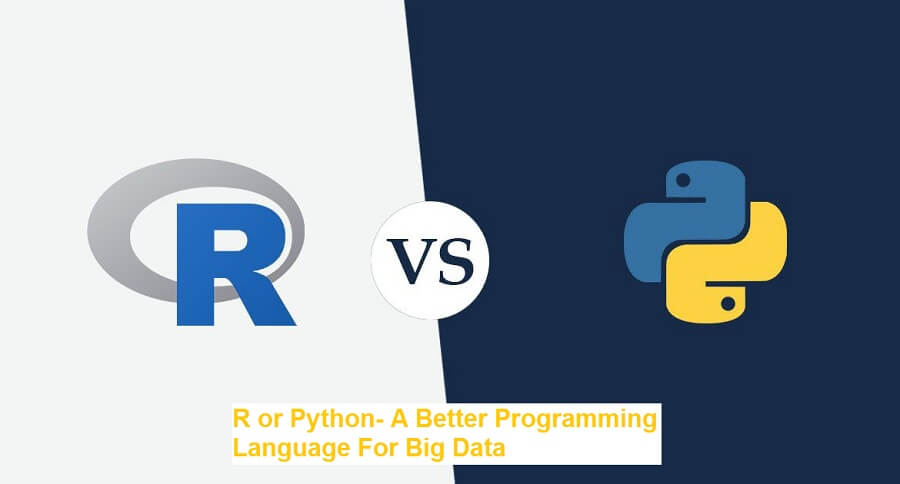Python is a multi-paradigm programming language: a kind of Swiss Army knife for the coding world. Python can perform all tasks, from data mining to website creation and integrated systems, all in one single language. And because Python is so widespread in its community, there are many resources specific to Python’s use in its field. Python is a popular, universal programming language with an emphasis on legibility and allows developers to use fewer lines of code to perform tasks than in older languages. Python is a top language, which means that it has many advantages, which accelerate code development. Python provides support for object-oriented programming and advanced data structures such as lists, tuples, kits, dictionaries, etc. R is considered the best programming language for every statistic because it has a comprehensive catalog of statistical and graphical methods. R is a powerful scripting language and very flexible with a vibrant community and back – up resources, while Python is a widely used, easy-to-learn and debug-oriented language.

R is an open-source and software environment for Statistical and graphics processing, supported by the R Foundation for Statistical Processing. Julia is a high-level dynamic programming language designed to meet the demands of high-performance numerical analysis, and scientific computing is rapidly gaining popularity among data scientists. Scala is the perfect language choice for people who work with large datasets and is fully supported by functional programming and a powerful static system. However, there is no specific sequence to list the popular languages for data science, Python and R fighting for the first place.
Python is a fully-fledged programming language and many organizations use it in their production systems. Python, on the other hand, is a better choice for machine learning because of its flexibility in production, especially when data analysis needs to be integrated into web applications. Python is a powerful and versatile language that developers can use for various computer tasks. When you hire Python developers, also take the time to be familiar with this programming language. Learning Python helps you develop a comprehensive data science toolkit, and it’s a versatile programming language that you can easily learn as a non – programmer.
The basic library of Julia, written largely in Julia itself, also integrates mature, best-of-breed open-source C and Fortran libraries for linear algebra, to produce random numbers, process signals, and process strings. Julia, probably not as well-known as R or Python tutorial, is described as a dynamic programming language of high quality for numerical calculations. Julia offers productivity and efficiency equivalent to five major programming languages, including R, Python, MATLAB, C and FORTRAN. Julia’s computer builds professional software tools to make it easier for organizations, especially in the financial world, to use Julia’s language, which is particularly suitable for demanding tasks such as data analysis and machine learning.
If you are planning to start or advance your Big Data and its careers, we have outlined three popular programming languages that you may want to learn to give your career a boost: R, Python, and Hadoop. Python is another programming language that is recommended for people who want to enter large Data or its fields. 8 Like R, Python’s programming language is used in many different software packages and industries.
Common mathematical operations such as multipliers of tables outside the box and array-based syntax of the language make it easier to translate mathematics into codes, especially for someone with no or minimal programming background. Python is a universal programming language that can do almost everything you need: data recovery, data engineering, data acquisition, web application development and many more. In addition, since Python is an object-oriented programming language, it is easier to write large-scale, maintainable and robust code with it than with R Using Python, the prototype code that you write on your own computer can serve as production code if necessary.
Traditional numerical programming languages such as Python are usually relegating the type of bookkeeping that data frames automatically transfer to the program. Pandas, Python’s data library, has many of the same functions, but RPy2 is creating a nice way to migrate from R to Python and allows you to learn a lot about R as an incidental supplement to Python learning. For example, I have used this approach to Python, which reads certain sensor data, processes it with RPy2 and then presents it to the user in various ways.
R, Python, and the new entrant Julia are currently three of the most popular programming languages chosen for large industrial Data projects. R and Python continue to be the dominant masters in data and analysis-oriented programming languages, but there are several other languages that attract attention for their usefulness in the field. Julia has built-in features built into the basic language, which makes it particularly suitable for working with large data streams that the industry wants to work with these days, such as parallelization and – databases.
There are two powerful analytical languages for Data Science, Python and R are Both open source languages, in which R is designed for statistics, while Python is very popular for its understandable syntax. R focuses on easy-to-use data analysis and graphical models, but Python’s focus is on readability and code productivity. Intellipaat is a well-known e-learning platform that offers the best online courses in Data Science, Python, R, and many other advanced technologies.
R is considered the best programming language for every statistic because it has a comprehensive catalog of statistical and graphical methods. R is a powerful scripting language and very flexible with a vibrant community and back – up resources, while Python is a widely used, easy-to-learn and debug-oriented language. Keras is now one of the easiest ways to familiarize yourself with deep learning in Python, and it also explains why KerasR and Keras packages are an interface for such a fantastic R user kit.